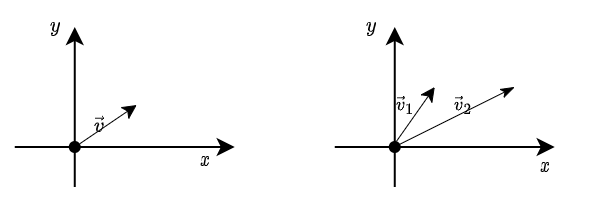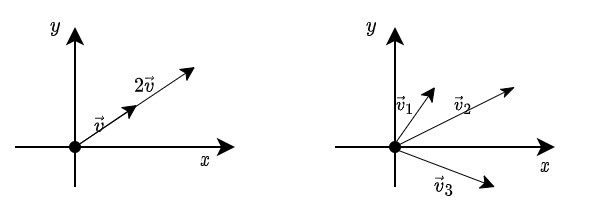Basic Definitions in Linear Algebra
Vector
In \(2\)-dimension space, we learned that each vector \(\textbf{v}\) has two components \(x\) and \(y\), is denoted \(\textbf{v} = [x, y]^T \in \mathbb{R}^2\).
In \(3\)-dimension space, a 3D vector \(\textbf{v}\) includes 3 components \(\textbf{v} = [x, y, z]^T \in \mathbb{R}^3\).
Expanding this idea, in $n$-dimension space, a vector \(\textbf{v}\) will have \(n\) components \(\textbf{v} = [v_1, v_2, ..., v_n]^T \in \mathbb{R}^n\)
Independence
Definition:
A set of vectors \(\textbf{v}_1, \textbf{v}_2, ..., \textbf{v}_n \in \mathbb{R}^n\) are independent if no combination gives zero vector \(\textbf{0}\) (except the zero combination - all \(c_i = 0\))
\[c_1\textbf{v}_1 + c_2\textbf{v}_2+ ... + c_n\textbf{v}_n \neq \textbf{0}\](except \(c_1 = c_2 = ... = c_n = 0\))
| Independent | Not Independent |
|---|---|
 |
 |
Space
Definition :
Vectors \(\textbf{v}_1, \textbf{v}_2, ..., \textbf{v}_l\) span a space means the space consists of all the linear combinations of these vectors.
Example:
Two vectors \(\textbf{v}_1 = [1, 1, 0]\) and \(\textbf{v}_2 = [2, 1, 1]\) span a space and vector \(\textbf{v}_3 = 2\textbf{v}_1 + \textbf{v}_2 = [4, 3, 1]\) is a part of the space.
Basics
Definition :
Basics of a space is a sequence of vectors \(\textbf{v}_1, \textbf{v}_2, ..., \textbf{v}_d\) with 2 properties:
- They are independent.
- They span the space.
Example :
Space \(\mathbb{R}^3\) have:
-
One basics is \(\left[\begin{matrix} 1 \\ 0 \\ 0 \end{matrix}\right]\), \(\left[\begin{matrix} 0 \\ 1 \\ 0 \end{matrix}\right]\), \(\left[\begin{matrix} 0 \\ 0 \\ 1 \end{matrix}\right]\).
-
Another basics is \(\left[\begin{matrix} 2 \\ 0 \\ 0 \end{matrix}\right]\), \(\left[\begin{matrix} 0 \\ 3 \\ 0 \end{matrix}\right]\), \(\left[\begin{matrix} 0 \\ 0 \\ 4 \end{matrix}\right]\).
-
But not this \(\left[\begin{matrix} 2 \\ 2 \\ 5 \end{matrix}\right]\), \(\left[\begin{matrix} 1 \\ 1 \\ 3 \end{matrix}\right]\) since they do not span \(\mathbb{R}^3\). Even though we add another vector \(\left[\begin{matrix} 3 \\ 3 \\ 8 \end{matrix}\right]\), it does not help since they are still dependent. The solution in here is to put a vector that is not in the plane created by these two vectors.
Dimension of a space
Definition :
The number of vectors in basics for the space is called DIMENSION of THE SPACE.
Example :
-
The space spanned by column vectors of \(A = \left[\begin{matrix} 1 & 2 & 3 & 1 \\ 1 & 1 & 2 & 1 \\ 1 & 2 & 3 & 1 \end{matrix}\right]\) has 2 dimensions (which is also its rank).
-
The space spanned by column vector of \(A = \left[\begin{matrix} -1 \\ -1 \\ 1 \\ 0 \end{matrix}\right]\) has 1 dimensions (which is also its rank).